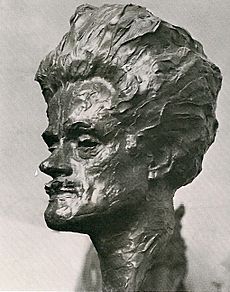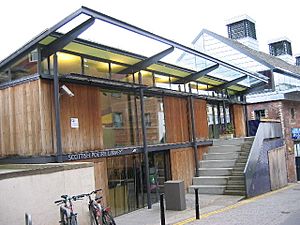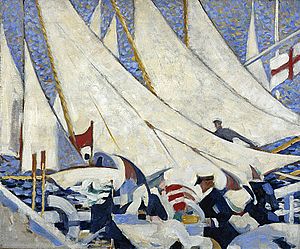Scottish Renaissance facts for kids
The Scottish Renaissance was a big cultural movement in Scotland during the early to mid-20th century. It was Scotland's own version of modernism, a time when people wanted to create new and exciting things. While it's often called the Scottish literary renaissance, its influence spread much wider. It touched music, art, and even politics.
Writers and artists involved in this movement were very interested in modern ideas and technology. But they also loved and used Scottish folk traditions. They cared deeply about Scotland's languages that were slowly disappearing. This movement was similar to other cultural revivals around the world, like the Irish Literary Revival and the Harlem Renaissance in the USA.
Contents
How the Scottish Renaissance Began
The name "Scottish Renaissance" became popular thanks to a French poet named Denis Saurat in 1924. However, the idea had been around earlier. A Scottish thinker named Patrick Geddes and writer Christopher Murray Grieve (who later became Hugh MacDiarmid) had used the term before.
Connecting to Past Movements
These early ideas show how the Scottish Renaissance was linked to the Celtic Twilight and Celtic Revival movements. These earlier movements from the late 1800s helped bring back a sense of Scottish pride. But while the older movements were often sentimental, the new Renaissance looked both to the past and the future. It admired medieval Scottish poets like William Dunbar and Robert Henryson. It also looked to modern writers like T. S. Eliot and Ezra Pound.
Early Signs of Change
Around the start of the 1900s, new energy appeared in Scottish arts. Writers like George Douglas Brown criticized the "Kailyard school" of writing. This style often showed Scottish rural life in a very sweet, old-fashioned way. Instead, Brown wrote realistic novels like The House with the Green Shutters (1901).
Poets like Violet Jacob and Marion Angus quietly brought back poetry in the Lowland Scots language. Patrick Geddes continued his work in town planning, thinking about how people connect with their local areas. In art, John Duncan created Symbolist paintings inspired by Celtic myths. He started using collage and flat images.
In design, Charles Rennie Mackintosh and the Glasgow Four created a unique "Glasgow style." This showed Scotland was buzzing with creative activity. But at first, these artists didn't all feel like they were part of one big national movement.
Literary Revival: A New Voice for Scotland

The Scottish Renaissance truly began with the literary work of Hugh MacDiarmid. Starting in 1920, he published anthologies called Northern Numbers. These featured works by Scottish poets, including himself. He also started and edited the Scottish Chapbook review in 1922. These efforts made MacDiarmid the central figure of the new movement.
The Rise of Synthetic Scots
Around 1925, MacDiarmid mostly stopped writing in English. He began writing in a new style called "synthetic Scots" or Lallans. This was a mix of different regional Scots dialects. He also used old words found in dictionaries, often putting them into a Standard English grammar structure.
Other writers soon followed MacDiarmid's lead. Poets like Edwin Muir and William Soutar explored identity and social issues in Lallans. After World War II, poets like Robert Garioch and Sydney Goodsir Smith also wrote in Scots. Edwin Morgan became famous for translating works from many European languages. He was also the first Scots Makar, Scotland's official national poet, appointed in 2004. Alexander Gray was known for translating German and Danish ballads into Scots.
Novels and New Perspectives
After the 1930s, the Scottish Renaissance focused more on novels. Neil Gunn became a leading figure. His novels, like The Grey Coast (1926), were mostly in English. They explored the Scottish Highlands and used new ways of telling stories.
Many other important novelists joined the movement. These included George Blake, A. J. Cronin, Eric Linklater, and Lewis Grassic Gibbon. There were also many talented female authors. These included Catherine Carswell, Willa Muir, Nan Shepherd, and Naomi Mitchison. They all explored identity and social issues, moving away from old-fashioned ideas.
A. J. Cronin's early novels, like Hatter's Castle (1931) and The Citadel (1937), showed the tough lives of ordinary people. He became the most translated Scottish author of the 20th century. George Blake wrote about working-class experiences in The Shipbuilders (1935). Eric Linklater wrote comedies, like Private Angelo (1946), which criticized modern war.
Lewis Grassic Gibbon created one of the most important works of the Renaissance. His trilogy A Scots Quair (including Sunset Song, 1932) mixed different Scots dialects in its storytelling. Other writers like James Barke and J. F. Hendry also wrote about working-class life.
Gaelic Poetry's Rebirth
The revival of Gaelic poetry was largely due to Sorley Maclean. He was a native Gaelic speaker from Skye. His poem Dàin do Eimhir (Poems to Eimhir, 1943) broke old rules and opened new doors for Gaelic writing. His work inspired a new generation of poets. These included George Campbell Hay, Derick Thomson, and Iain Crichton Smith. They wrote about themes like exile, the future of the Gaelic language, and being part of two cultures.
Art: A Modern Scottish Look
The idea of a unique modern Scottish art appeared between the World Wars. Artists like Stanley Cursiter, William McCance, William Johnstone, and J. D. Fergusson were key figures. Stanley Cursiter was influenced by the Celtic revival, post-impressionism, and Futurism. You can see this in his paintings like Regatta (1913). He later became director of the National Gallery of Scotland.
Fergusson was one of the few British artists involved in creating modernism. His interest in machines can be seen in paintings like Damaged Destroyer (1918). He worked with MacDiarmid on a journal called Scottish Art and Letters.
William McCance's early work was bold and post-impressionist. He later moved towards abstraction, influenced by vorticism. His work Women on an Elevator (1925) shows this. William Johnstone also moved towards abstraction. He tried to combine landscape, poetry, and Celtic art. His most important work, A Point in Time (1929–38), is considered a very important Scottish painting of the century.
Other artists influenced by modernism included James McIntosh Patrick and Edward Baird. Both trained in Glasgow and focused on landscapes, often influenced by surrealism. McIntosh Patrick's Traquair House (1938) and Baird's The Birth of Venus (1934) are examples.
Drama: Scottish Stories on Stage
Playwrights connected to the Scottish Renaissance include Robert McLellan, Robert Kemp, and Alexander Reid. Robert McLellan's early plays were often produced in Glasgow. His comedy Toom Byres (1936) was a success. Jamie the Saxt (1937), featuring King James VI, confirmed his reputation as a comic writer in Scots.
Robert Kemp was a pioneer in translating plays into Scots. His Let Wives Tak Tent (1948) was a Scots version of Molière's L'Ecole des femmes. He also adapted David Lyndsay's Ane Pleasant Satyre of the Thrie Estaitis for the Edinburgh International Festival. Kemp also helped found the Gateway Theatre Company.
While McLellan's plays were set in the distant past, Alexander Reid preferred half-mythic settings. His plays The Lass wi' the Muckle Mou (1950) and The Warld's Wonder (1953) drew on legends and famous figures like Thomas the Rhymer and Michael Scot.
Victor Carin later directed plays at the Gateway Theatre. He expanded the range of Scottish theatre by translating more works. His Scots translation of Molière's The Imaginary Invalid was performed in 1963.
Sydney Goodsir Smith's play The Wallace was a major contribution. It was first broadcast on radio in 1959 and then staged at the Edinburgh International Festival in 1960.
Music and Dance: New Scottish Sounds
The ideas of the Scottish Renaissance also reached classical music. Francis George Scott, MacDiarmid's former teacher, set many of the poet's works to music. Ronald Stevenson also used Scottish music to create his own style. He set folk songs and wrote concertos for the piano. He also adapted works by Scottish Renaissance poets like MacDiarmid and William Soutar.
Robin Orr and Cedric Thorpe Davie were influenced by modernism and Scottish musical styles. Erik Chisholm also showed modernist influence in his music, like the Pibroch Piano Concerto (1930). In 1928, he founded the Scottish Ballet Society (later the Celtic Ballet) with choreographer Margaret Morris. They created several ballets, including The Forsaken Mermaid (1940).
Decline and Lasting Influence

By the 1960s, the most revolutionary part of the Scottish Renaissance had passed. Other international movements became more popular.
However, the Scottish Renaissance had a deep and lasting effect. It strongly influenced the Scottish independence movement. The roots of the Scottish National Party can be found in this cultural revival. The Renaissance also helped bring back interest in both of Scotland's native languages.
Major Figures of the Scottish Renaissance
Many people were part of the Scottish Renaissance. Here are some of the key figures:
- George Bain: Led a revival of Celtic art.
- Alan Bold: Biographer and critic of MacDiarmid.
- James Bridie: Playwright.
- George Mackay Brown: Poet, author, and dramatist.
- Catherine Carswell: Novelist and biographer.
- A.J. Cronin: Doctor and novelist.
- Helen Cruickshank: Poet and social figure.
- Robert Garioch: Poet.
- Isabel Frances Grant: Ethnographer (studies cultures).
- George Campbell Hay: Poet and translator.
- John MacDougall Hay: Novelist and journalist.
- Robert Hurd: Architect.
- Moultrie Kelsall: Television producer and actor.
- Jessie Kesson: Novelist and playwright.
- Archie Lamont: Poet and nationalist writer.
- William Lamb: Sculptor.
- Maurice Lindsay: Poet and critic.
- Eric Linklater: Novelist and politician.
- Norman MacCaig: Poet.
- William McCance: Painter.
- Fionn MacColla: Novelist and historian.
- Compton MacKenzie: Novelist and journalist.
- Agnes Mure Mackenzie: Writer and historian.
- Moray McLaren: Writer.
- F. Marian McNeill: Folklorist (studies folklore).
- Naomi Mitchison: Novelist, memoirist, and activist.
- Edwin Morgan: Poet.
- Willa Muir: Novelist and translator.
- R. Crombie Saunders: Poet, editor, journalist, and teacher.
- Nan Shepherd: Novelist and poet.
- Tom Scott: Poet, translator, and critic.
- George Scott-Moncrieff: Novelist, playwright, poet, and journalist.
- David Cleghorn Thomson: Journalist and broadcaster.
- Derick Thomson: Poet.
- Wendy Wood: Political campaigner, artist, and writer.
- Douglas Young: Poet, translator, and essayist.
Later Influences
These people came after the main Renaissance period but were strongly influenced by it:
- John Cairney
- Duncan Glen
- William Neill (poet)
- James Robertson (novelist and poet)
- Iain Crichton Smith: Poet and novelist.
- John Herdman
- Tom Hubbard
See also
- Alasdair Gray
- Ian Hamilton Finlay
- Muriel Spark
- Celtic Revival
- Highland Revival
- Scottish Gaelic Renaissance
- Scottish national identity


